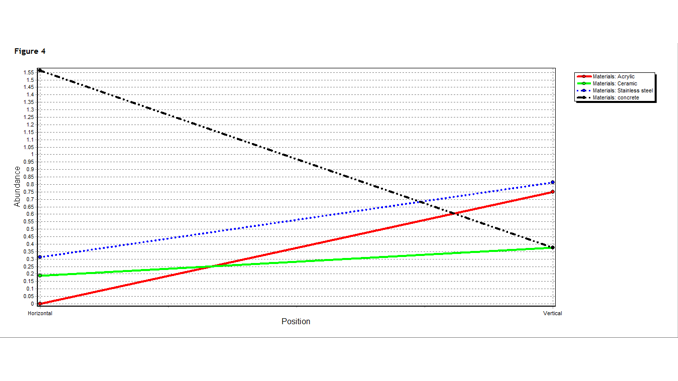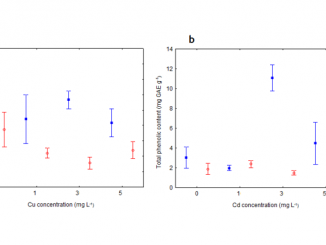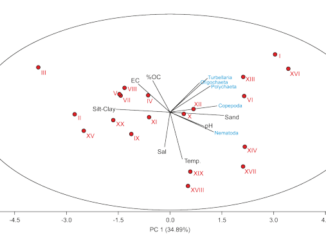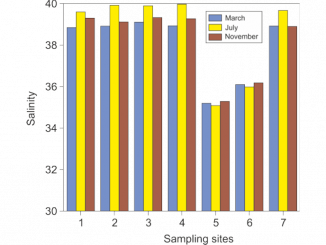
Paper category: Original research paper
Corresponding author: Sathianeson Satheesh (satheesh_s2005@yahoo.co.in)
DOI: 10.2478/ohs-2019-0023
Received: 05/11/2018
Accepted: 21/01/2019
Full text: here
Citation (APA style): Mohsin A. Al-Sofyani, A. & Satheesh, S. (2019). Recruitment patterns of the solitary ascidian Phallusia nigra Savigny, 1816 on artificial substrates submerged in the central Red Sea, Saudi Arabia. Oceanological and Hydrobiological Studies, 48(3), pp. 262-269. Retrieved 3 Oct. 2019, from doi:10.2478/ohs-2019-0023
Abstract
The solitary ascidian Phallusia nigra is commonly found on hard substrates along the Jeddah coastal waters of the central Red Sea. In this study, the recruitment pattern of P. nigra on artificial substrates was assessed in relation to their type, surface color and orientation. The results showed a higher recruitment rate of the ascidian species on concrete and dark panels. The abundance of the ascidian on test panels varied between the four seasons. The orientation (vertical or horizontal) of the panels did not show any major difference in the recruitment. Significant effects of light intensityon the recruitment of P. nigra were observed on test panels, with higher abundance on panels submerged in the shade. In conclusion, this study clearly indicates the importance of the type and color of substrates in the recruitment of ascidians on artificial materials.
References
Azevedo, F.B.B., Carloni, G.G. & Carvalheira, L.V. (2006). Colonization of benthic organisms on different artificial substratum in Ilha Grande bay, Rio de Janeiro, Brazil. Braz. Arch. Biol. Technol. 49: 263–275. DOI: 10.1590/S1516-89132006000300012.
Baynes, T.W. (1999). Factors structuring a subtidal encrusting community in the southern Gulf of California. Bull. Mar. Sci. 64: 419–450.
Bullard, S.G., Lambert, G., Carman, M.R., Byrnes, J., Whitlatch, R.B. et al. (2007). The colonial ascidian Didemnum sp. A: current distribution, basic biology and potential threat to marine communities of the northeast and west coasts of North America. J. Exp. Mar. Biol. Ecol. 342: 99–108. DOI: 10.1016/j.jembe.2006.10.020.
Bullard, S.G., Davis, C.V. & Shumway, S.E. (2013). Seasonal patterns of ascidian settlement at an aquaculture facility in the Damariscotta River, Maine. J. Shellfish. Res. 32(2): 255–264. DOI: 10.2983/035.032.0202.
Bulleri, F. & Chapman, M.G. (2010). The introduction of coastal infrastructure as a driver of change in marine environments. J. Appl. Ecol. 47(1): 26–35. DOI: 10.1111/j.1365-2664.2009.01751.x.
Chase, A.L., Dijkstra, J.A. & Harris, L.G. (2016). The influence of substrate material on ascidian larval settlement. Mar. Pollut. Bull. 106(1–2): 35–42. DOI: 10.1016/j.marpolbul.2016.03.049.
Darbyson, E., Locke, A., Hanson, J.M. & Willison, J.M. (2009). Marine boating habits and the potential for spread of invasive species in the Gulf of St. Lawrence. Aquat. Invasions 4(1): 87–94. DOI: 10.3391/ai. 2009.4.1.9.
De Felice, R.C., Eldredge, L.G. & Carlton, J.T. (2001). Nonindigenous marine invertebrates. In L.G. Eldredge & C. Smith (Eds.), A Guidebook of Introduced Marine Species in Hawaii (pp. bi–bvi). Honolulu: Bishop Museum Technical Report.
Dean, T.A. (1981). Structure aspects of sessile invertebrates as organizing forces in an estuarine fouling community. J. Exp. Mar. Biol. Ecol. 53: 163–180.
Dobretsov, S., Abed, R.M. & Voolstra, C.R. (2013). The effect of surface colour on the formation of marine micro and macrofouling communities. Biofouling 29(6): 617–627. DOI: 10.1080/08927014.2013.784279.
Ells, V., Filip, N., Bishop, C.D., DeMont, M.E., Smith-Palmer, T. et al. (2016). A true test of colour effects on marine invertebrate larval settlement. J. Exp. Mar. Biol. Ecol. 483: 156–161. DOI: 10.1016/j.jembe.2016.07.011.
Glasby, T.M. (2000). Surface composition and orientation interact to affect subtidal epibiota. J. Exp. Mar. Biol. Ecol. 248: 177–190.
Glasby, T.M. & Connell, S.D. (2001). Orientation and position of substrata have large effects on epibiotic assemblages. Mar. Ecol. Prog. Ser. 214: 127–135.
Holmstrom, C. & Kjelleberg, S. (1994). The effect of external biological factors on settlement of marine invertebrate and new antifouling technology. Biofouling 8(2): 147–160.
Kim, I.H., Cruz-Rivera, E., Sherif, M.E.D. & El-Sahhar, S. (2016). Cyclopoid copepods (Ascidicolidae, Notodelphyidae) associated with Phallusia nigra Savigny, 1816 (Ascidiacea) in the Red Sea: a new ascidicolid and first descriptions of the males from two notodelphyids. J. Crustac. Biol. 36(4): 553–566. DOI: 10.1163/1937240X-00002439.
Knott, N.A., Underwood, A.J., Chapman, M.G. & Glasby, T.M. (2004). Epibiota on vertical and horizontal surfaces on natural reefs and on artificial structures. J. Mar. Biol. Ass. UK 84: 1117–1130.
Kondilatos, G., Corsini-Foka, M. & Pancucci-Papadopoulou, M.A. (2010). Occurrence of the first non-indigenous ascidian Phallusia nigra Savigny, 1816 (Tunicata: Ascidiacea) in Greek waters. Aquat. Invasions 5(2): 181–184. DOI: 10.3391/ai.2010.5.2.08.
Lambert, G. (2002). Nonindigenous ascidians in tropical waters. Pacific. Sci. 56: 291–298.
Lopez-Legentil, S., Ruchty, M., Domenech, A. & Turon, X. (2005). Life cycles and growth rates of two morphotypes of Cystodytes (Ascidiacea) in the western Mediterranean. Mar. Ecol. Prog. Ser. 296: 219–228.
Marins, F.O., Novaes, R.L., Rocha, R.M. & Junqueira, A.O. (2010). Non indigenous ascidians in port and natural environments in a tropical Brazilian bay. Zoologia 27(2): 213–221. DOI: 10.1590/S1984-46702010000200009.
Miller, R.J. & Etter, R.J. (2008). Shading facilitates sessile invertebrate dominance in the rocky subtidal Gulf of Maine. Ecology 89: 452–462.
Mizrahi, D., Navarrete, S.A. & Flores, A.A. (2014). Uneven abundance of the invasive sun coral over habitat patches of different orientation: An outcome of larval or later benthic processes? J. Exp. Mar. Biol. Ecol. 452: 22–30. DOI: 10.1016/j.jembe.2013.11.013.
Novak, L., Lopez-Legentil, S., Sieradzki, E. & Shenkar, N. (2017). Rapid establishment of the non-indigenous ascidian Styela plicata and its associated bacteria in marinas and fishing harbors along the Mediterranean coast of Israel. Mediterr. Mar. Sci. 18(2): 324–331. DOI: 10.12681/mms.2135.
Oren, U. & Benayahu, Y. (1998). Didemnid ascidians: rapid colonizers of artificial reefs in Eilat (Red Sea). Bull. Mar. Sci. 63(1): 199–206.
Pineda, J., Porri, F., Starczak, V. & Blythe, J. (2010). Causes of decoupling between larval supply and settlement and consequences for understanding recruitment and population connectivity. J. Exp. Mar. Biol. Ecol. 392: 9–21. DOI: 10.1016/j.jembe.2010.04.008.
Rodriguez, S.R., Ojeda, F.P. & Inestrosa, N.C. (1993). Settlement of benthic marine invertebrates. Mar. Ecol. Prog. Ser. 97(2): 193–207.
Salama, A.J., Satheesh, S. & Balqadi, A.A. (2018a). Biofouling community development on nylon net panels submerged in the central Red Sea coast, Saudi Arabia. Cah. Biol. Mar. 59: 517–525. DOI: 10.21411/CBM.A.EA4208FE.
Salama, A.J., Satheesh, S. & Balqadi, A.A. (2018b). Development of Biofouling Communities on Nylon Net Panels Submerged in the Central Red Sea: Effects of Season and Depth. Thalassas 34(1): 199–208. DOI: 10.1007/s41208-017-0052-z.
Satheesh, S. & Wesley, S.G. (2008). Seasonal variability in the recruitment of macrofouling community in Kudankulam waters, east coast of India. Estuar. Coast. Shelf. S. 79(3): 518–524. DOI: 10.1016/j.ecss.2008.05.008.
Satheesh, S. & Wesley, S.G. (2010). Influence of substratum colour on the recruitment of macrofouling communities. J. Mar. Biol. Ass. UK 90(5): 941–946. DOI: 10.1017/S0025315410000032.
Satheesh, S. & Wesley, S.G. (2011). Influence of submersion season on the development of test panel biofouling communities in a tropical coast. Estuar. Coast. Shelf. S. 94(2): 155–163. DOI: 10.1016/j.ecss.2011.06.011.
Shenkar, N., Zeldman, Y. & Loya, Y. (2008). Ascidian recruitment patterns on an artificial reef in Eilat (Red Sea). Biofouling 24(2): 119–128. DOI: 10.1080/08927010801902083.
Shenkar, N. (2012). Ascidian (Chordata, Ascidiacea) diversity in the Red Sea. Marine Biodiversity 42: 459–469. DOI: 10.1007/s12526-012-0124-5.
Siddik, A.A., Al-Sofyani, A.A., Ba-Akdah, M.A. & Satheesh, S. (2018). Invertebrate recruitment on artificial substrates in the Red Sea: role of substrate type and orientation. J. Mar. Biol. Ass. UK. DOI: 10.1017/S0025315418000887.
Sokołowski, A., Ziółkowska, M., Balazy, P., Kukliński, P. & Plichta, I. (2017). Seasonal and multi-annual patterns of colonisation and growth of sessile benthic fauna on artificial substrates in the brackish low-diversity system of the Baltic Sea. Hydrobiologia 790: 183–200. DOI: 10.1007/s10750-016-3043-9.
Swain, G., Herpe, S., Ralston, E. & Tribou, M. (2006). Short-term testing of antifouling surfaces: the importance of colour. Biofouling 22: 425–429. DOI: 10.1080/08927010601037163.
Swami, B.S. & Chhapgar, B.F. (2002). Settlement pattern of ascidians in harbour waters of Mumbai, west coast of India. Indian J. Mar. Sci. 31(3): 207–212.
Tracy, B.M., Larson, K.J., Ashton, G.V., Lambert, G., Chang, A.L. et al. (2017). Northward range expansion of three non-native ascidians on the west coast of North America. BioInvasions Rec. 6(3): 203–209. DOI: 10.3391/bir.2017.6.3.04.
Valdez, B., Ramirez, J., Eliezer, A., Schorr, M., Ramos, R. et al. (2016). Corrosion assessment of infrastructure assets in coastal seas. J. Mar. Eng. Technol. 15(3): 124–134. DOI: 10.1080/20464177.2016.1247635.
Van Duyl, F.C., Bak, R.P.M. & Sybesma, J. (1981). The ecology of the tropical compound ascidian Trididemnum solidum. I. Reproductive strategy and larval behaviour. Mar. Ecol. Prog. Ser. 35–42.
Van Dolah, R.F., Wendt, P.H., Knott, D.M. & Wenner, E.L. (1988). Recruitment and community development of sessile fouling assemblages on the continental shelf off South Carolina, USA. Estuar. Coast. Shelf. S. 26(6): 679–699.
Vandepas, L.E., Oliveira, L.M., Lee, S.S.C., Hirose, E., Rocha, R.M. et al. (2015). Biogeography of Phallusia nigra: is it really black and white? Biol. Bull. 228: 52–64.
Walker, S.J., Schlacher, T.A. & Schlacher–Hoenlinger, M.A. (2007). Spatial heterogeneity of epibenthos on artificial reefs: fouling communities in the early stages of colonization on an East Australian shipwreck. Marine Ecology 28: 435–445.
Whalan, S., Wahab, M.A.A., Sprungala, S., Poole, A.J. & De Nys, R. (2015). Larval settlement: the role of surface topography for sessile coral reef invertebrates. PloS one 10: e0117675.
Young, C.M. & Chia, F.S. (1984). Microhabitat-associated variability in survival and growth of subtidal solitary ascidians during the first 21 days after settlement. Mar. Biol. 81(1): 61–68.
Zhan, A., Briski, E., Bock, D.G., Ghabooli, S. & MacIsaac, H.J. (2015). Ascidians as models for studying invasion success. Mar. Biol. 162: 2449–2470. DOI: 10.1007/s00227-015-2734-5.




Bądź pierwszy, który skomentuje ten wpis